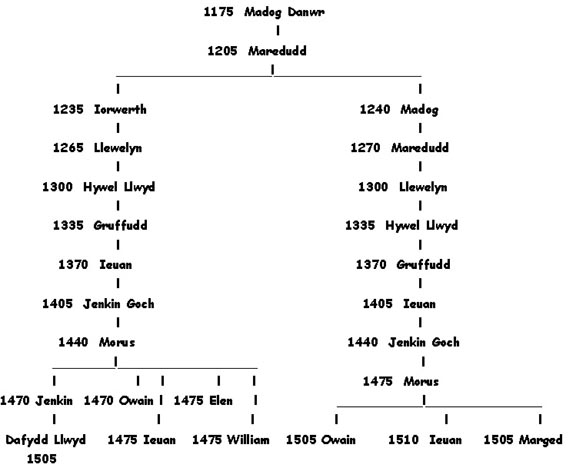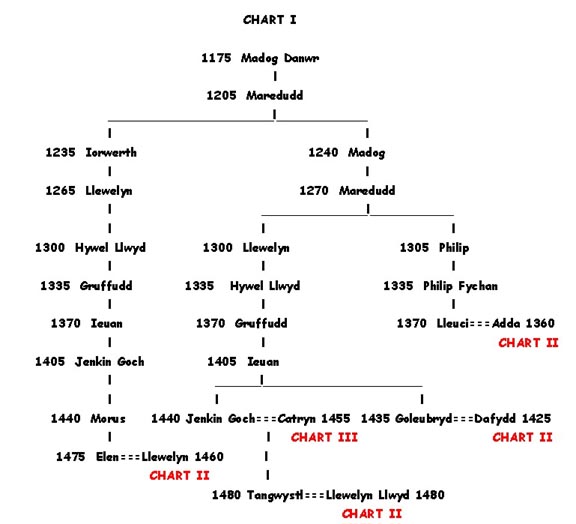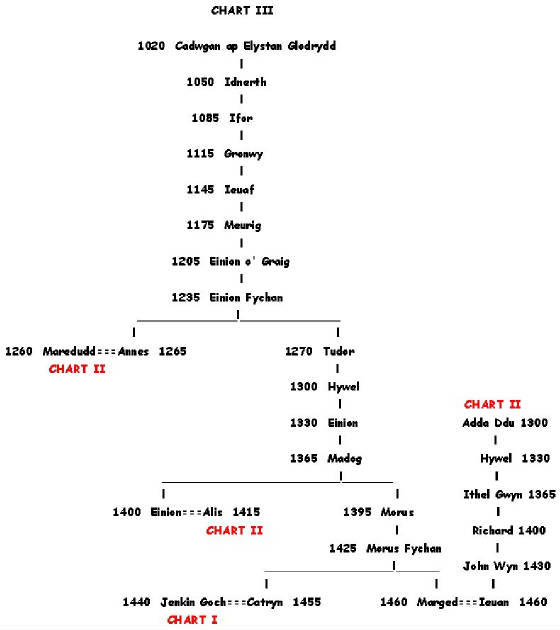MADOG DANWR, LORD OF LLANGURIG PARISH
By Darrell Wolcott
Born c. 1175 as Madog ap Ieuan ap Maredudd ap Madog ap Gruffudd ap Dafydd ap Cynwrig
ap Rhiwallon ap Dyngad ap Tudor Trefor, he appears to be a man who had to leave his ancestral home in the commote of Maelor
in north Powys to find his fortune elsewhere. He joined up with Gwenwynwyn, King of south Powys, and served that monarch
as a senior field commander during the period 1200-1215.
On the battlefield, he was called "Danwr" or fire-maker. The nickname is a
mutation of the Welsh word "taniwr", and a form of the verb "tanio", meaning "to ignite a fire". It is not known whether
he lit grass fires as a battle tactic or merely used fire to destroy the wooden walls of that era's Welsh forts. To
reward his services, King Gwenwynwyn granted him the Lordship of the parish of Llangurig in southern Arwystli, together with
a large tract of land within that parish. He was also given a lady of Buellt for his wife, the daughter and only child
of Idnerth ap Maredudd Hen ap Seisyll ap Llewelyn ap Cadwgan ap Elystan Glodrydd. [1] On his Arwystli land, he erected a manor
called Clochfaen, the "bell manor". We are nowhere told, but might assume there was a bell tower attached to his residence.
Madog Danwr had an eldest son, Maredudd, born c. 1205. who succeeded him as Lord
of Llangurig and baron of the manor Clochfaen. A younger son, Gruffudd, was given a portion of Madog's land upon
which he built his residence, Cefn yr Hafodan or "the summer dwelling on the ridge". A single source (Peniarth 287, 4) claims
Madog had a 3rd son, Idnerth Goch, but none of the men claimed as his descendants have named wives and there is no way to
date them. The historian, Edward Hamer, who wrote the earliest history of Llangurig Parish, mentions this Idnerth, but
wrote nothing at all about his lands or his descendants. It is possible that Idnerth received his mother's lands in
Buellt. It is also possible that he was actually a son of Madog ap Maredudd ap Madog Danwr.
Maredudd ap Madog Danwr had, by an unknown wife [2], an eldest son, Iorwerth, born c. 1235
who inherited Clochfaen, but the Lordship of Llangurig became extinct with the death of his father. Maredudd also had younger
sons Madog, Philip and Gruffudd. Our paper will follow both Iorwerth and Madog, grandsons of Madog Danwr, since
their families have been conflated by every authority who cited the pedigrees of either man. The following chart will
show why most thought this was a single family:

The left-hand column of our chart depicts the senior branch of the family
which was seated at Clochfaen. The family on the right is headed by Madog, a younger brother of Iorwerth ap Maredudd,
who inherited a part of his grandfather's tract of land where he built his own manor called Dolfachwen, or "small white
meadow", The conflation of the two families is evident in most pedigrees of the Dolfachwen family, as virtually all
of them call the c. 1270 Maredudd "ap Madog Danwr". Like his same-named grandfather, this later Maredudd ap Madog named 3
of his sons Iorwerth, Philip and Gruffudd. It was his eldest son, Llewelyn, who began the long tradition of copycat names, when he named a son Hywel Llwyd.
Beginning with Maredudd ap Madog, Bartrum's charts and dating scheme follow
the junior line at Dolfachwen, which he labels as the Clochfaen line and co-mingles the children of each subsequent generation.
Of the spouses he assigns, some belong to men of the senior line and others to men of the junior line. In one case,
Bartrum assigns a man two wives who were born 30 years apart, and is the only case where both same-named men in these families
have an identified wife.
CLOCHFAEN FAMILY:
1. Maredudd ap Madog Danwr, born c. 1205 His wife is unknown, but all the known citations match
him with the lady who married the c. 1270 Maredudd ap Madog of the Dolfachwen family.
2. Iorwerth ap Maredudd, born c. 1235. He married a daughter (1250) ferch Ieuan Goch (1220) ap Gronwy
(1190) ap Meilyr (1160) ap Gwallog (1125) ap Gwaithfoed (1090) ap Llewelyn (1055) ap Cadwgan (1020) ap Elystan Glodrydd. [3]
He had sons named Llewelyn, Philip and Ieuan.
3. Llewelyn ap Iorwerth, born c. 1265. His wife is unknown. He had sons Hywel Llwyd and Philip.
4. Hywel Llwyd ap Llewelyn, born c. 1300. His wife is unknown. He had sons Gruffudd ap Dafydd.
5. Gruffudd ap Hywel Llwyd. born c. 1335. He married a daughter (1350) ferch Rhys Llwyd (1320) ap
Ieuan (1290) ap Rhys (1260) ap Gruffudd (1225) ap Rhys (1195) ap Iorwerth (1165) ap Cadifor (1130) ap Gwaithfoed of Meirionydd
(1100). [4] He had sons Ieuan and Rhys.
6. Ieuan ap Gruffudd, born c. 1370. Virtually all extant pedigrees assign him 2 wives, but one of
these ladies married the later Ieuan ap Gruffudd in the Dolfachwen family. The present Ieuan married Gwenllian (1380)
ferch Ieuan (1345) ap Gruffudd (1310) ap Iorwerth (1275) ap Philip (1240) ap Maredudd (1205) ap Madog Danwr [5], a distant
cousin. He was the father of a single child, Jenkin Goch.
7. Jenkin Goch ap Ieuan, born c. 1405. His wife is unknown but virtually all writers assign him
the wife of his namesake in the cousin family. He had a single child, Morus
8. Morus ap Jenkin Goch, born c. 1440. He married Marged (1440) ferch Llewelyn (1405) ap Rhys Llwyd
(1375) ap Ieuan (1345) ap Rhys (1315) descended from Cadifor ap Gwaithfoed of Meirionydd. [6] He had sons Jenkin, Owain,
Ieuan and William, and daughters, Elen, Mallt and Goleubryd. The bard Huw Cae Llwyd (obit 1504) dedicated a poem to
the 4 boys as fine examples of young Welshmen, brave in battle. Their sister, Elen, born c. 1475, married Llewelyn (1460)
ap Morus (1430) ap Rhys (1395) ap Adda (1360) ap Hywel (1330) ap Adda Ddu (1300) ap Gruffudd (1270) ap Maredudd Ddu (1235)
ap Maredudd (1200) ap Einion (1170) ap Cynfelyn (1140) of Arwystli. [7] Nothing more is known of the other 2 daughters.
9. Jenkin ap Morus, born c. 1470. He married Catryn (1475) ferch Morgan (1440) ap Rhys (1400) ap
Hywel (1370) ap Dafydd Llwyd (1340) descended from Cadifor ap Dyfnwal of Castle Hywel, Ceredigion. [8] He had sons, Dafydd
Llwyd and Ieuan.
10. Dafydd Llwyd ap Jenkin, born c. 1505. He married Catryn (1505) ferch Ieuan (1470) ap Dafydd (1440) ap
Ieuan (1405) ap Gruffudd aka Gutto (1375) ap Maredudd (1345) descended from Rhys ap Llowdden ap Iorwerth of Ceredigion. [9]
At some point in the 16th century, the senior line of the Clochfaen family adopted
"Lloyd" as their surname. Dafydd Llwyd ap Jenkin had a son, Ieuan, whose son, Rhys Llwyd, was father to Jenkin.
This Jenkin, born c. 1595, was the grandfather of Jenkin ap Rhys, whose grandson, also named Jenkin ap Rhys, had an only daughter,
Sarah Lloyd, born 1746. She married Rev Thomas Youde and one of their daughters, Harriet, married Jacob W. Hinde.
They had an eldest son, William Hinde, who styled himself Jacob Youde William, born c. 1818. He apparently managed to
acquire the old Lloyd manor house, Clochfaen, or at least, permission to make it his personal residence. He sought and
was granted Royal permission to change his surname to Lloyd, and during the years 1881-1887, he published his "History of
Powys Fadog" in 6 volumes as "J.Y.W. Lloyd". [10]
DOLFACHWEN FAMILY:
1. Maredudd ap Madog ap Maedudd ap Madog Danwr, born c. 1270. He is the Maredudd who married a lady
descended from Meilyr Gryg II. Bartrum cited the only source [11] which called her Arddun ferch Llewelyn ap Einion ap
Llewelyn ap Meilyr Gryg II, but such a lady would be a full generation too young for such a marriage. Two other sources
[12] agree that she was Arddun ferch Einion ap Llewelyn ap Meilyr Gryg II, a lady born c. 1285. Maredudd ap Madog had
4 sons, Llewelyn, Iorwerth, Philip and Gruffudd.
2. Llewelyn ap Maredudd, born c. 1300. No wife is known for him. The marriage Bartrum assigned
him was Efa ferch Hywel ap Iorwerth ap Trahaearn Goch ap Iorwerth Fychan ap Iorwerth ap Trahaearn, Lord of Garthmyl, a lady
born c. 1350. His source [13] called her husband Llewelyn ap Iorwerth, but he "corrected" it to Llewelyn ap Maredudd.
She was actually the wife of Llewelyn (1340) ap Iorwerth (1305) ap Philip (1270) ap Iorwerth (1235) ap Maredudd (1205) ap
Madog Danwr. The c. 1300 Llewelyn named his only known son, Hywel Llwyd, after his older cousin at Clochfaen
3. Hywel Llwyd ap Llewelyn, born c. 1335. his wife is unknown and his only known child was
a son, Gruffudd.
4. Gruffudd ap Hywel Llwyd, born c. 1370. His wife is unknown, but he had a son, Ieuan.
5. Ieuan ap Gruffudd, born c. 1405. He married Gwenhwyfar (1410) ferch Rhys (1375) ap Dafydd
(1340) ap Ieuan (1310) ap Rhys (1275) ap Llewelyn (1245) ap Caradog (1210) ap Richard (1175) ap Einion (1140) ap Richard (1105)
ap Einion (1065) ap Cadifor Fawr. [14] He had a daughter, Goleubryd, born c. 1435, who married [15] Dafydd (1425) ap
Rhys (1395) ap Adda (1360) ap Hywel (1330) ap Adda Ddu (1300) descended from Einion ap Cynfelyn of Arwystli, the first of
that name. He also had a son, Jenkin Goch.
6. Jenkin Goch ap Ieuan, born c. 1440. He married Catryn (1455) ferch Morus Fychan (1425) ap Morus
(1390) ap Madog (1360) descended from Ifor ap Idnerth ap Cadwgan ap Elystan Glodrydd. [16] He had daughters Tangwystl,
Deili, Catryn and Anne, and sons Ieuan and Morus.
7. Morus ap Jenkin Goch, born c. 1475. His wife is unknown, but he had sons Owain and Ieuan and
daughters Gwenllian and Marged. This Marged (1505) married [17] Thomas (1495) ap Dafydd Teg (1455) ap Ieuan (1425) descended
from Gronwy ap Einion ap Seisyll (the 2nd of that name).
Sources available to us end here, so we do not know if this branch of the family also adopted Lloyd as
their surname, when that practice became common after 1500. Nor do we know at what point they stopped copying the same sequence
of male birth names first used by the Clochfaen family.
Notes:
[1]
Montgomeryshire Coll. II, 270
[2]
The marriage usually claimed for him actually belongs to his same-named grandson.
[3]
Pen. 128, 733b; Pen. 138, 593
[4]
Powys Fadog II, 203
[5]
Pen. 128, 723b & 725b
[6]
Pen. 128, 723b
[7]
ibid
[8]
Montgomeryshire Coll. II. 273
[9]
ibid
[10]
Powys Fadog II, 247/257
[11]
Harl. 1973, 116
[12]
Powys Fadog II, 201 and Mont. Coll,II, 270
[13]
Powys Fadog II, 202
[14]
Pen. 128, 721b
[15] ibid
[16] Pen. 128, 723b & 725b
[17] Powys Fadog II, 218
APPENDIX:
In the 13th to the 16th centuries,
these families of Langurig Parish often intermarried with two nearby families: a branch of the family descended from
Ifor ap Idnerth ap Cadwgan ap Elystan Glodrydd, and two branches descended from the Rhos family of Rhiwallon ap Madog, which
relocated to Maesmawr in Arwystli in the 12th century. We show those marriage connections in the following charts:


|

